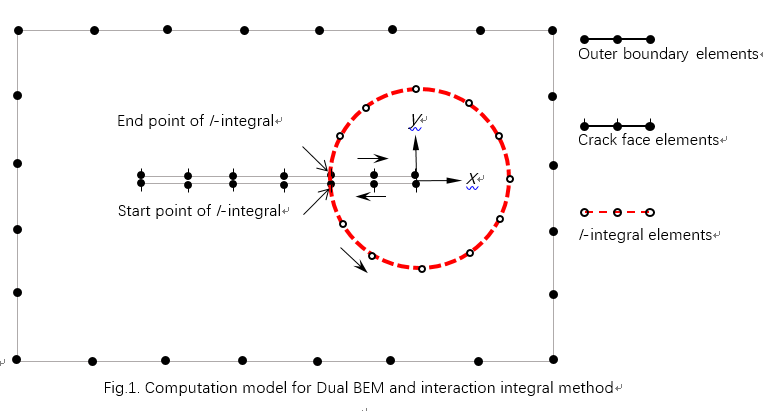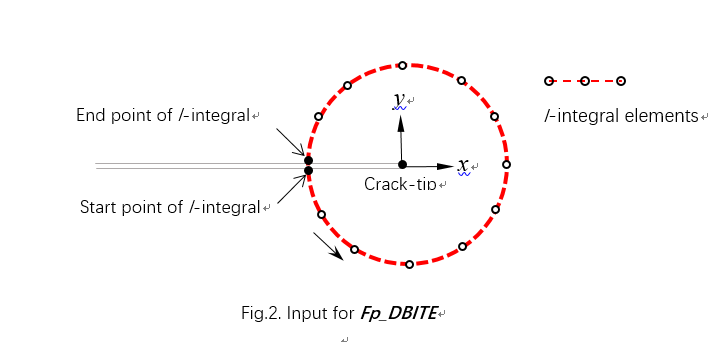博文
Evaluation of SIFs and T-stress by Dual BEM and I-integral
|
Description :
This
is a self-contained computer code—Fp_DBIT.F90 (Fracture Parameters
evaluation based on Dual BEM and I-Integral method) developed for
evaluating stress intensity factors and T-stress for mixed-mode cracks
of elastic solids.
This code is written in Fortran 90 (keeping to Fortran77 style make it easy to understand) and consists of the main program and six subroutines. This code can evaluate the fracture parameters given that the elastic variables, displacement gradients and stresses, has been solved by the Dual BEM. Fig.1 shows the computation model of combined Dual BEM and I-integral method.

Input File: (FPPOST.dat)
The Main program Fp_DBIT inputs the coordinates of nodes which constructs the path of I-integral, as shown in Fig.2. The detailed description of the input data are listed below:

Card Set 1: Information for the No. of crack-tip and the No. of the I-integral path;
Card Set 2:
G: shear modulus;
PR: Poisson’s ratio;
NSIG: 3 for plane stress, or 4 for plane strain;
CDTIP(i), i=x or y: The i-coordinate of the crack-tip in global coordinate system;
COSL(i,1:2), i =x or y : The i-th coordinate axis of the local Cartesian coordinate system.
Card Set 3:
NJP: The number of nodes those construct the I-integral path as shown in Fig.2;
NJE: The number of boundary elements those construct the I-integral path as shown in Fig.2;
NODJ: The number of nodes within one I-integral elements;
NGSSJ: The number of Gauss points used for do Gauss quadrature of the I-integral elements.
Card Set 4:
ID: The No. of points used in the Fp_DBIT;
IP: The original ID of the point which is input from Dual_BEM program;
CD(i, ID), i=x or y: The i-coordinate for the location of point ID in global coordinates;
UGD(i, j, ID), i, j=x, y: The displacement gradient of the point with the No. of ID.
SIG(i, j, ID), i, j=x, y: The stress for the point with the No. of ID.
Card Set 5:
LNDJ(1, IE): Global node number for the 1st node of element IE;
LNDJ(2, IE): Global node number for the 2nd node of element IE;
LNDJ(2, IE): Global node number for the 3rd node of element IE;
Output File: (RESULTS.out)
FP(1): Stress intensity factor KI for pure I mode;
FP(2): Stress intensity factor KII for pure II mode;
FP(3): T-stress.
Source File:
PROGRAM Fp_DBIT IMPLICIT REAL*8 (A-H,O-Z) ALLOCATABLE:: IDP(:),CD(:,:),UGD(:,:,:),SIG(:,:,:),LND(:,:) DIMENSION CDTIP(2),COSL(2,2),CKL(2,3),UGDL(2,2,3),SIGL(2,2,3), & & POSGJ(4),WEITJ(4),VI(3),VI0(3),FP(3) OPEN(5,FILE='FPPOST.DAT',STATUS='OLD') OPEN(7,FILE='FPRESULTS.OUT',STATUS='UNKNOWN') READ(5,*); READ(5,*); READ(5,*) READ(5,*) G,PR,NS,(CDTIP(I),I=1,2),((COSL(I,J),J=1,2),I=1,2) READ(5,*); READ(5,*) READ(5,*) NJP,NJE,NODJ,NGSSJ; READ(5,*); READ(5,*) ALLOCATE(IDP(NJP),CD(2,NJP),UGD(2,2,NJP),SIG(2,2,NJP),LND(NODJ,NJE)) DO IP=1,NJP READ(5,*)ID,IDP(IP),(CD(I,IP),I=1,2),((UGD(I,J,IP),J=1,2),I=1,2),& & (( SIG(I,J,IP),J=1,2),I=1,2) ENDDO READ(5,*); DO IE=1,NJE; READ(5,*) (LND(ID,IE),ID=1,NODJ); ENDDO IF(NS.EQ.4)THEN; ALFA=2.*G/(1.-PR); ELSEIF(NS.EQ.3)THEN ALFA=2.*G*(1+PR); ENDIF CALL GAUSSVI(NGSSJ,POSGJ,WEITJ) ! FOR INTEGRATION FOR r VI(1:3)=0. DO 100 IE=1,NJE CALL LOCAL_VAB(NODJ,CDTIP,COSL,CD,UGD,SIG,LND(:,IE),CKL,UGDL,SIGL) DO 100 IG = 1 , NGSSJ CALL EVAL_IKE(NODJ,CKL,UGDL,SIGL,POSGJ(IG),G,PR,NS,FJCB,VI0) 100 VI(1:3)=VI(1:3)+VI0(1:3)*FJCB*WEITJ(IG) FP(1:2)=0.5*ALFA*VI(1:2); FP(3)=ALFA*VI(3) WRITE(*,'(3(A8,F12.6))') 'KI:',FP(1),'KII:',FP(2),'T:',FP(3) WRITE(7,'(3(A8,F12.6))') 'KI:',FP(1),'KII:',FP(2),'T:',FP(3) END SUBROUTINE LOCAL_VAB(NODJ,CDTIP,COSL,CD,UGD,SIG,LND,CKL,UGDL,SIGL) IMPLICIT REAL*8 (A-H,O-Z) DIMENSION CDTIP(2),COSL(2,2),LND(NODJ),CD(2,*),UGD(2,2,*),SIG(2,2,*) DIMENSION CKL(2,3),UGDL(2,2,3),SIGL(2,2,3) DO 100 ID = 1, NODJ IP=LND(ID); CKL(:,ID)=0.; UGDL(:,:,ID)=0.; SIGL(:,:,ID)=0. DO K=1,2 DO L=1,2 CKL(K,ID)=CKL(K,ID)+COSL(K,L)*(CD(L,IP)-CDTIP(L)) DO I=1,2 DO J=1,2 UGDL(K,L,ID)=UGDL(K,L,ID)+COSL(K,I)*UGD(I,J,IP)*COSL(L,J) SIGL(K,L,ID)=SIGL(K,L,ID)+COSL(K,I)*SIG(I,J,IP)*COSL(L,J) ENDDO ENDDO ENDDO ENDDO 100 CONTINUE ENDSUBROUTINE ! SUBROUTINE GAUSSVI(NGAUS,GP,GW) IMPLICIT REAL*8 (A-H,O-Z) DIMENSION GP(NGAUS),GW(NGAUS) SELECT CASE(NGAUS) CASE(2) GP(1)=-0.57735026918962D0; GW(1)=1.D0 GP(2)= 0.57735026918962D0; GW(2)=1.D0 CASE(3) GP(1)=-0.77459666924148D0; GP(2)=0.D0 GP(3)= 0.77459666924148D0 GW(1)= 0.55555555555556D0; GW(2)=0.88888888888888D0 GW(3)= 0.55555555555556D0 CASE(4) GP(1)=-0.86113631159405; GP(2)=-0.33998104358486 GP(3)= 0.33998104358486; GP(4)= 0.86113631159405 GW(1)= 0.34785484513745; GW(2)= 0.65214515486255 GW(3)= 0.65214515486255; GW(4)= 0.34785484513745 ENDSELECT ENDSUBROUTINE SUBROUTINE SHAPI(NODE,SP,X,CK,CP,RI,R2) IMPLICIT REAL*8 (A-H,O-Z) DIMENSION SP(NODE),CK(2,*),CP(2),RI(2),X(*) ! 2 noded-element (line element) SP(1)=0.5D0*(1.D0-X(1)); SP(2)=0.5D0*(1.D0+X(1)) IF(NODE.EQ.2) GOTO 50 ! 3 noded-element (line element) SP(1)=-X(1)*SP(1); SP(2)=X(1)*SP(2); SP(3)=1.D0-X(1)*X(1) GOTO 50 ! Calculate r and its vector components 50 R2=0.D0; DO 70 I=1,2; RI(I)=-CP(I) DO ID=1,NODE; RI(I)=RI(I)+SP(ID)*CK(I,ID); ENDDO 70 R2=R2+RI(I)*RI(I) ENDSUBROUTINE SUBROUTINE DSHAPI(NODE,X,CK,COSB,FJCB,DN,GD,IFCOS) IMPLICIT REAL*8 (A-H,O-Z) DIMENSION X(*),CK(2,*),DN(2,NODE),GD(2,2),COSB(2),GR(2) DN(1,1)=-0.5D0; DN(1,2)=0.5D0 ! For 2D, 2 noded-element IF(NODE.EQ.2) GOTO 30 DN(1,1)=-0.5D0*(1.D0-2.D0*X(1)) ! For 2D, 3 noded-element DN(1,2)=0.5D0*(1.D0+2.D0*X(1)); DN(1,3)=-2.D0*X(1) 30 DO 50 I=1,2; DO 50 J=1,1; GD(I,J)=0.D0; DO 50 ID=1,NODE 50 GD(I,J)=GD(I,J)+DN(J,ID)*CK(I,ID) GR(1)=GD(2,1); GR(2)=-GD(1,1) ! For 2D normals FJCB=DSQRT(DOT_PRODUCT(GD(1:2,1),GD(1:2,1))) ! LINE JACOBIAN IF(IFCOS.EQ.0) RETURN COSB(1:2)=GR(1:2)/FJCB ! Normal Cosine ENDSUBROUTINE ! SUBROUTINE EVAL_IKE(NODJ,CKL,UGDL,SIGL,POSGJ,G,PR,NS,FJCB,VI0) IMPLICIT REAL*8 (A-H,O-Z) DIMENSION CKL(2,3),UGDL(2,2,3),SIGL(2,2,3),POSGJ(4),SHAP(NODJ), & & CP0(2),RI(2),COSB(2),DN(2,NODJ),GD(2,2),ACTDU(2,2),ACTSIG(2,2), & & auxdu(2,2),auxsig(2,2) DIMENSION TRAC1(2),TRAC2(2),VI0(3) CP0=0.; PI=3.141592654d0 CALL SHAPI(NODJ,SHAP,POSGJ,CKL,CP0,RI,R2) CALL DSHAPI(NODJ,POSGJ,CKL,COSB,FJCB,DN,GD,1) IF(RI(1).LT.0.)THEN; IF(RI(2).LT.0.)THEN THETA=-(PI-DATAN(RI(2)/RI(1))) ELSEIF(RI(2).GT.0.)THEN; THETA=PI+DATAN(RI(2)/RI(1)); ENDIF ELSE; THETA=DATAN(RI(2)/RI(1)) ENDIF; R=DSQRT(R2) IF(NS.EQ.3)THEN; AK=(3.D0-PR)/(1.D0+PR); ELSEIF(NS.EQ.4)THEN AK=3.D0-4.D0*PR; ENDIF ACTDU(:,:)=0.; ACTSIG(:,:)=0. DO ID=1,NODJ ACTSIG(:,:) = ACTSIG(:,:) + SHAP(ID)*SIGL(:,:,ID) ! Stress ACTDU(:,:) = ACTDU(:,:) + SHAP(ID)*UGDL(:,:,ID) ! Displacement gradient ENDDO DO 50 IMOD=1,3 CALL AUXI_SOLUTION(G,PI,PR,AK,R,THETA,auxdu,auxsig,IMOD) ! Auxiliary solution for mixed-mode SIF SEGY = 0. DO I = 1,2 DO J=1,2; SEGY = SEGY + ACTSIG(I,J) * auxdu(I,J); ENDDO TRAC1(I)=DOT_PRODUCT(ACTSIG(I,1:2),COSB(1:2)) TRAC2(I)=DOT_PRODUCT(auxsig(I,1:2),COSB(1:2)) ENDDO TMP1=DOT_PRODUCT(TRAC1(1:2),auxdu(1:2,1)) TMP2=DOT_PRODUCT(TRAC2(1:2),ACTDU(1:2,1)) 50 VI0(IMOD)=SEGY*COSB(1)-(TMP1+TMP2) ENDSUBROUTINE
Input File for Example:

Computed Results:
KI: 2.615375 KII: 2.403349 T: -0.352381
File package:![]() Fp_DBIT.zip
Fp_DBIT.zip
https://blog.sciencenet.cn/blog-3421240-1202715.html